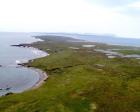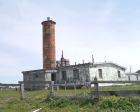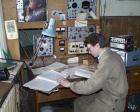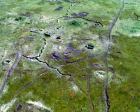
Looking along the point with the Kuril Islands in the distance. The light
house is at the far tip.

The light house with its four foot thick walls.

Putting out the weather report.

Second Would War trenches.
(Click on any Image to see a higher resolution version)
Yesterday was by far the hottest day were have experienced here in four years. It got to 29 C or 84 F and the previous high was 22 C - 71 F. Not very hot compared to other places we hear about on the short wave radio. To take advantage of the calmness that went along with the warm day I decided to go to the very southern tip of the peninsula. I have made it there only one other time even though it is only 25 miles from our cabin. That time it was blowing too hard to land on the small lake about one kilometer from the lighthouse. Even yesterday it was at the limit where I felt safe to land. There isn't a tree within 40 miles to get behind, just rolling tundra. Near the tip I was having to crab at a severe angle to make slow progress in the direction that I wanted to go but the air was very smooth and predictable. This is said to be one of the windiest places in the world, almost as bad as Cape Horn. It is only thirteen kilometers from the northernmost Kuril Island and one can see three of the islands. During the second world war the Japanese captured these islands and it is very interesting to see all the tools of the war laying about with very little disturbance. The Russians dug in at the tip, determined to hold them from coming onto the mainland. The Americans were allies at the time and had a air base an a big meadow down stream from the Kurilskoy Lake salmon research station. There are still the anti aircraft guns in place just as they were walked away from, 55 years ago and miles and miles of trenches. Eight miles from our cabin there is an American B 26 light bomber that crash landed in the pine bush and is still there half burned.
My problem as usual was that no one at the small settlement spoke English but with my very few words of Russian and their odd word of English, I was able to get a bit of the picture of life in this God forsaken place while I had tea with the manager. They had three horses last year when I flew over but when I asked where the third one was they indicated that they ate it during the winter. We have heard that people often go crazy in the winter because the wind rarely lets up enough that you can safely walk around without blowing away but I need an interpreter to get the details of how they cope with their hardships. I saw six people (there might have been more), two of which were women. Our tea was interrupted by the need to send out a weather report at 1 p.m. so I followed the guy into his radio room after he ran out to read all the instruments. His barometer was the original graduated vacuum tube standing in its bowl of mercury beside his desk. He wrote them into a book and then fired up the telegraph and started talking to someone in Morse Code. He could sure send it out fast! I was impressed; I thought that it was a long lost art. And for all his skills and hardships of staying there, he probably works for the grand sum of US $50. a month. I was most impressed with the thickness of the walls of the two buildings that I was in. They were about four feet through and this was not for protection from the Japanese but a desperate attempt to get away from the wind.
As I flew out of the little lake, there were two fat young bears that looked similar to Biscuit and Chico in the grassy dunes up from the beach. They were probably three year olds and I wondered if they might become among the specialist bears who live on the many sea otter that come ashore there for some reason. From my understanding the sea otter of North America live their whole life in the sea, never coming to shore. As I flew along I saw several of these giant otters loping along the beach and I could see why these bears might risk going out on that ten mile by one mile long point where there is nothing to hide behind except the many rusty ship wrecks that litter both shores. The previous year I discovered a technique that some use to hide. One spotted me coming with the plane well before I got to it and when I looked again it had disappeared suddenly. When I got to the spot there was no possible place he could have gone without my seeing him except into the big surf. Sure enough, when I looked closely I could see him among the big waves, almost impossible to spot. I was impressed! My biologist friend Igor Revenko who spent some time at the light house studying the bears and sea otters once saw a bear enter the rough water at the tip and keep swimming. Igor said that there was a strong current and the bear had to crab in it like I do in the air to keep from being washed into the middle of the north Pacific; but he kept going as long as Igor could watch him with binoculars. Igor had heard that people on a ship had seen one crossing the isthmus between the peninsula and the first island so it seems that is why the first two Kuril Islands have brown bear populations.
Charlie